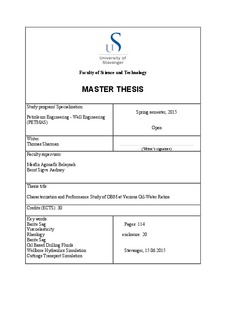| dc.contributor.author | Sharman, Thomas | |
| dc.date.accessioned | 2015-09-21T12:49:26Z | |
| dc.date.available | 2015-09-21T12:49:26Z | |
| dc.date.issued | 2015 | |
| dc.identifier.uri | http://hdl.handle.net/11250/300921 | |
| dc.description | Master's thesis in Petroleum engineering | nb_NO |
| dc.description.abstract | Drilling fluids are an essential part of the drilling operation. One of the
main functions of a properly maintained drilling fluid is to suspend cuttings,
as well as weighting materials, in static conditions. Insufficient gel strength or
low-shear viscosity can enhance settling of weight material, known as barite
sag. Some drilling fluids display elastic and viscous characteristics at lowshear
rates. This means that the fluid possess solid-like and liquid-like qualities.
This is known as viscoelasticity. It is thought that viscoelastic behavior can
give an advantageous knowledge about dynamic settlement. This involves
studies of drilling fluids viscoelastic behavior at deformation rates far below
the conventional viscometer range.
This study assess the influence of increasing water fraction in oil based drilling
fluids with the use of viscoelastic measurements, computing of the Unified
hydraulics model and cuttings transport simulation. Four different oil based
drilling fluids were used in this study. The density was equal for all samples at
1750 kg/m3 with an oil-water ratio increasing from 60:40 towards 90:10 and at
the same time keeping the viscosifying-clay concentration constant.
The experiments conducted in this thesis included dynamic and static sag
measurements to asses which fluid was most susceptible for barite sag. In
addition to conventional rheological methodology, a total of five different
types of viscoelastic measurements was included in the search for a qualitative
characterization. Viscosity profiles at shear rates far beyond conventional
viscometer was obtained from a shear rate ramp. In the evaluation of yield
stress in drilling fluids, a controlled stress ramp was performed.
A performance evaluation has been performed with the use of hydraulic
wellbore simulation and cuttings transport simulation. This was performed by
computing the Unified hydraulics model and by using Landmark’sWellPlan.
The experimental investigations shows that the water fraction in oil based
drilling fluids has a significant impact when the drilling fluid was formulated
with 7 kg/m3 organophilic clay. The fluid sample with the lowest water fraction
showed a behavior of a viscoelastic liquid, while the remaining samples
showed viscoelastic gel characteristics. These characteristics are shown to
be time and temperature dependent. The characterizations also included a
yield stress evaluation based upon five different measurements techniques,
which reveal that the apparent yield stress is much lower than estimated by
theHerschel-Bulkley model and Bingham Plastic model. Hydraulic simulation
showed that a higher water fraction impose an increase in ECD and pump
pressure, while the cuttings transport simulation showed a beneficial effect
from the increased water fraction. This is primarily caused by the higher
viscosity. | nb_NO |
| dc.language.iso | eng | nb_NO |
| dc.publisher | University of Stavanger, Norway | |
| dc.relation.ispartofseries | Masteroppgave/UIS-TN-IPT/2015; | |
| dc.subject | petroleumsteknologi | |
| dc.subject | petroleum engineering | |
| dc.subject | viscoelasticity | |
| dc.subject | rheology | |
| dc.subject | well engineering | |
| dc.title | Characterization and performance study of OBM at various oil-water ratios | nb_NO |
| dc.type | Master thesis | nb_NO |
| dc.subject.nsi | VDP::Technology: 500::Rock and petroleum disciplines: 510::Petroleum engineering: 512 | |
| dc.source.pagenumber | 134 | nb_NO |
